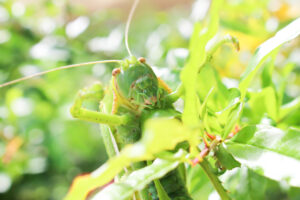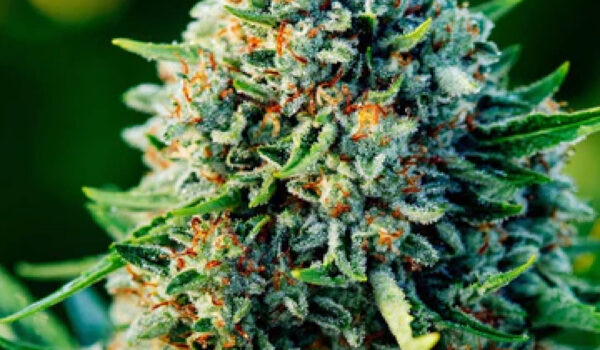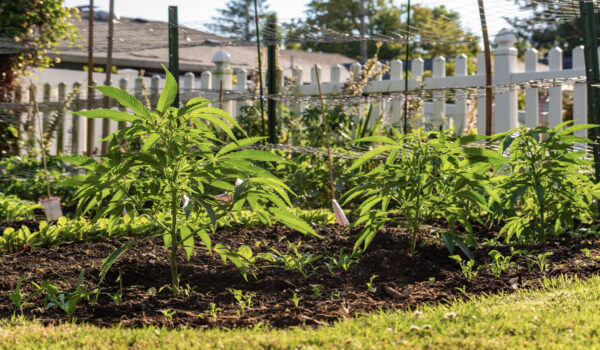
by Rincon-Vitova Insectary
Grasshoppers
Most grasshoppers are general feeders, but they prefer young green plants and some annual flowers. Chewing mouthparts make large, round, smooth holes in leaves. Heavy infestations can strip plants to stalks. During major outbreaks they feed on almost any green plant, and damage may occur over a considerably longer period.
Identification
Hind legs, have greatly enlarged femurs, are well adapted for jumping.
Antennae are relatively short versus crickets and katydids, which have long antennae.
Most are winged and are good fliers, although a few species are flightless.
Life Cycle
In late summer and in fall, adult females deposit eggs in soil in undisturbed areas: grassy foothills, ditch banks, etc.
Eggs hatch in spring, and young nymphs begin to feed on nearby plants.
Usually grasshoppers have only one generation a year. Adults can live two to three months.
Adults die out when food becomes scarce or when weather becomes too cold.
Monitoring Excerpt from Manitoba Hemp:
The probability of grasshopper pests is higher when production occurs near pasture or hay land.
Grasshoppers can move into the field in the spring if conditions are favorable for an early hatch.
Late season infestations can result in damaged seed heads and possibly reduced production.
Economic thresholds are unknown at this time.
Cultural Practices
When numbers are low, they can be handpicked and squashed.
Cones, screened boxes, floating row covers, and other covers provide some protection (Grasshoppers can eat through cloth or plastic row covers, try using metal window screening).
Chickens and guinea hens are excellent predators but can cause damage to some plants.
Set up bird houses, baths, and feeders, to attract predators.
Use companion plants to repel grasshoppers: cilantro, calendula (pot marigold), sweet clover, and horehound
Keep a trap border of tall grass or lush green plants around the perimeter of the garden to divert insects
Don’t mow this trap crop or let it dry out, or the grasshoppers will go straight into the garden
Use jar traps: sink glass jars into soil and fill half way with molasses mixture: 1 part molasses to 10 parts water.
Dust the leaves with thin layer of all purpose flour, which can cause starvation by gumming up their mouths.
Dust with Diatomaceous Earth: these jagged particles cut the insects and expose to desiccation & disease. It will need to be reapplied as it gets wet.
Neem oil – not for flowering plants (will leave smell/taste on buds)
Neem Oil (Azadirachtin): mimics IGRs: primarily kills immature insects (they fail to complete molts). It also acts as an antifeedant & repellant. Neem is less effective on aphids & some grasshoppers. Neem also breaks down in water – don’t mix more than needed. It persists 4-8 days as foliar spray, and weeks if drenched. Neem does not harm foraging bees.
Garlic Barrier spray: excellent repellent. Mix 2 oz Garlic Barrier, 1 Qt Fish Emulsion, and 5 Gal Water. Spray.
Homemade garlic spray, blend two bulbs of garlic with 10 cups of water and heat up the mixture until it starts to boil. Let the mixture sit overnight. To use, fill a spray bottle with one part garlic solution and three parts water.
Garlic Spray: garlic odor diminishes in about 30 minutes as the plants absorb it. Garlic Barrier travels through the plant systemically, protecting roots, stems, leaves, flowers and fruit.
Does not change the taste or smell for human, insects can’t stand the natural sulfurs absorbed from the garlic
Avoid using pesticides: Carbamates (carbaryl), Pyrethroids (bifenthrin, cyfluthrin, fluvalinate, and permethrin). These materials are highly toxic to natural enemies and pollinators.
Bio-Control
Nosema locustae baits containing the protozoan kill nymphs of migrating grasshopper nymphs early in the season.
Nosema baits are slow-acting and not intended for stopping sudden outbreaks.
Application Rates: Application Rates may vary among different commercial products. Read labels carefully.
25 bran flakes per sq ft
Beauveria bassiana (for aphids, thrips, WF)
68-86 °F >92% RH
An entomopathogenic fungus wide host range, including soft-bodied beneficials
Best for sap-sucking & chewing insects
Spores germinte on insects – kill in 2-10 days
Some strains have 3-7 day residual activity
Weekly applications can prevent insect population explosions
Application Rates: Application Rates may vary among different commercial products. Read labels carefully.
½ to 2 qt per 100 gallons for liquid emulsion suspension products
½ to 2 lbs per 100 gallons for wettable powder products
Weekly applications can prevent insect population explosions
Summary of Strategies
Hand picking
Row Covers
Trap grasses
Companion plants to repel
Garlic Sprays to repel
Flour dusting
Molasses bait traps
Nosema bait early
Beauveria bassiana early


